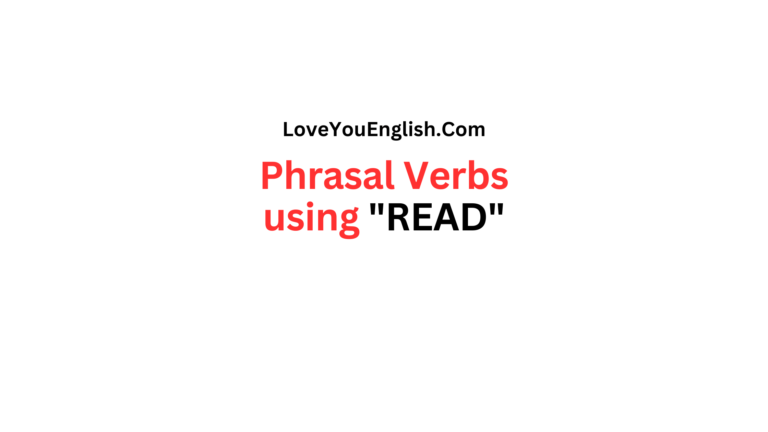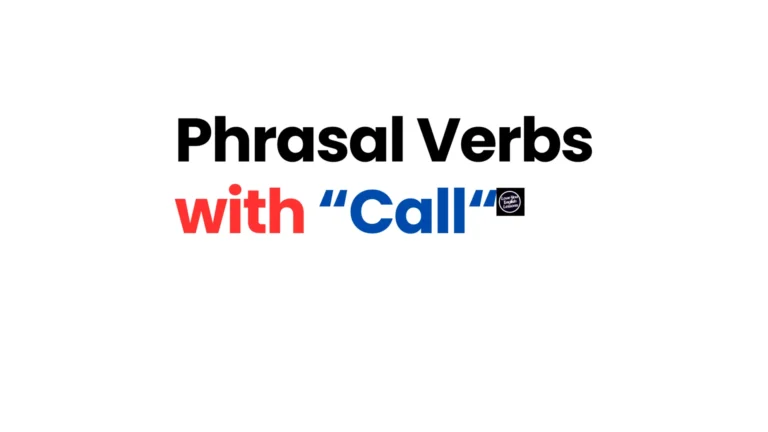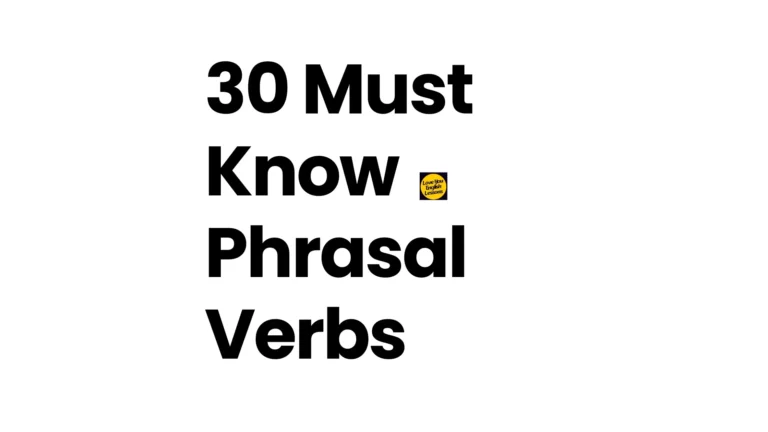English Grammar: Phrasal Verbs Guide
Here is the phrasal verbs guide.
Phrasal verbs are an essential part of English, especially in daily conversations.
They are combinations of a verb and one or more particles (such as prepositions or adverbs) that together create a unique meaning.
Mastering phrasal verbs can help you sound more natural and fluent in English.
In this guide, I will explain what phrasal verbs are, their types, how to learn them, and provide useful examples.
What Are Phrasal Verbs?
A phrasal verb is a verb combined with a preposition or an adverb (or both) to form a new meaning.
For example:
- Look after: To take care of someone or something.
- Break down: To stop working (usually for machines).
The meaning of a phrasal verb often cannot be guessed from the meanings of its individual words. This makes them tricky for learners but also very important to understand.
Why Are Phrasal Verbs Important?
Phrasal verbs are used frequently by native speakers in both formal and informal contexts.
Learning them can:
- Improve your listening and reading comprehension.
- Make your speech and writing sound more natural.
- Help you understand idiomatic expressions.
For example:
- Instead of saying, “He exited the car,” you might say, “He got out of the car.”
- Instead of “She started her business,” you might hear, “She set up her business.”
Types of Phrasal Verbs
Phrasal verbs can be divided into three main types based on how they behave:
1. Transitive and Intransitive Phrasal Verbs
- Transitive phrasal verbs require an object.
- Example: “She turned off the light.” (The light is the object.)
- Intransitive phrasal verbs do not take an object.
- Example: “The car broke down on the highway.”
2. Separable and Inseparable Phrasal Verbs
- Separable phrasal verbs allow the object to come between the verb and the particle.
- Example: “He turned the radio off.”
- Inseparable phrasal verbs do not allow separation.
- Example: “She looks after her younger brother.”
3. Literal and Idiomatic Phrasal Verbs
- Literal phrasal verbs have meanings that are easy to understand.
- Example: “He walked out of the room.”
- Idiomatic phrasal verbs have meanings that are not obvious.
- Example: “They ran out of milk.” (This means they no longer have milk.)
Common Phrasal Verbs and Their Meanings
Here is a list of common phrasal verbs grouped by categories to make them easier to learn:
1. Phrasal Verbs for Daily Activities
Wake up: To stop sleeping.
-
- “I wake up at 7 AM every day.”
Turn on: To start a machine or device.
-
- “Can you turn on the TV?”
Put on: To wear something.
-
- “She put on her jacket before going out.”
Run out of: To use all of something.
-
- “We ran out of sugar, so I can’t make tea.”
2. Phrasal Verbs for Travel
Get on: To board a vehicle (bus, train, plane).
-
- “Let’s get on the bus.”
Get off: To leave a vehicle.
-
- “We got off the train at the wrong station.”
Check in: To register at a hotel or airport.
-
- “We checked in at the hotel around noon.”
Set off: To start a journey.
-
- “They set off early to avoid traffic.”
3. Phrasal Verbs for Work and Study
Carry on: To continue doing something.
-
- “Please carry on with your work.”
Give up: To stop trying.
-
- “Don’t give up; you can do it!”
Look into: To investigate.
-
- “The manager is looking into the issue.”
Hand in: To submit something.
-
- “I need to hand in my assignment by Friday.”
4. Phrasal Verbs for Emotions
Calm down: To relax after being angry or stressed.
-
- “He tried to calm down after the argument.”
Cheer up: To become or make someone happier.
-
- “She cheered up after hearing the good news.”
Break down: To lose control of emotions.
-
- “She broke down and cried.”
5. Phrasal Verbs for Relationships
Get along with: To have a good relationship with someone.
-
- “I get along with my coworkers very well.”
Break up: To end a romantic relationship.
-
- “They broke up after five years together.”
Make up: To reconcile after an argument.
-
- “They had a fight but later made up.”
How to Learn Phrasal Verbs
Learning phrasal verbs can be challenging, but with the right strategies, it becomes easier:
1. Group Them by Topic
Instead of learning random phrasal verbs, group them into categories like travel, work, emotions, etc. This makes them easier to remember.
2. Learn Them in Context
Always learn phrasal verbs in sentences. For example, don’t just memorize “put off”; learn it as, “They put off the meeting until next week.”
3. Practice Regularly
Use phrasal verbs in your daily conversations and writing. The more you use them, the better you will remember them.
4. Use Flashcards
Create flashcards with the phrasal verb on one side and its meaning and example sentence on the other. Review them regularly.
5. Watch Movies and TV Shows
Phrasal verbs are commonly used in movies and TV shows. Pay attention to how they are used and try to incorporate them into your speech.
6. Keep a Vocabulary Notebook
Write down new phrasal verbs you encounter along with their meanings and example sentences.
Common Mistakes with Phrasal Verbs
1. Using the Wrong Preposition
Phrasal verbs are fixed expressions. Changing the preposition can change the meaning completely.
- Incorrect: “He looks after to his brother.”
- Correct: “He looks after his brother.”
2. Separating Inseparable Phrasal Verbs
Some phrasal verbs cannot be separated, even when there is an object.
- Incorrect: “She looks her children after.”
- Correct: “She looks after her children.”
3. Overusing Phrasal Verbs in Formal Writing
While phrasal verbs are common in spoken English, they may not always be appropriate in formal writing. Use their single-word equivalents when writing formally.
- Informal: “The meeting was called off.”
- Formal: “The meeting was canceled.”
Conclusion
Phrasal verbs are a key part of English and learning them can significantly improve your language skills.
Focus on understanding their meanings, practice using them in context, and be patient with yourself as you learn.
Over time, you’ll find that using phrasal verbs becomes second nature.
Happy learning!
Read more:
- English Dialogues About Blue Whales
- English Dialogues About Unemployment
- English Dialogues Practice: an HR and a Job Candidate







